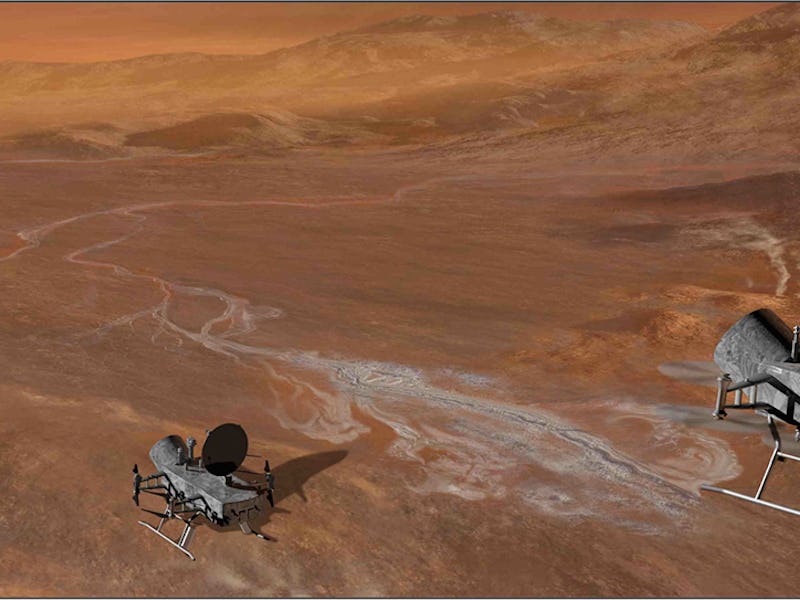This Badass Dual-Quadcopter Could Fly Around Saturn's Biggest Moon
Titan is perfect for drones.

Saturn’s moon Titan is a remarkable place. It’s the only moon in the solar system with a dense atmosphere, but it doesn’t get the same attention as potentially life-supporting satellites like Europa. That’s because Titan is a noxious, methane-soaked world, one barely suitable to a NASA rover, let alone lifee as we know it.
But all that would Titan perfect for drones to fly high over the planet, and NASA has just the idea: an eight-rotor craft called Dragonfly. The thick atmosphere is what makes flight possible, and researchers at the Johns Hopkins Applied Physics Laboratory are keen to take advantage of that with a flying rover that can explore sites hundreds of miles apart over a planned two-year mission.
“In just a few flights, Dragonfly will be able to go farther than Mars has in the last 12 years,” program manager Peter Bedini said in a presentation, the video of which is included below. “So it’s really a different paradigm.” In fact, because the moon’s atmosphere is significantly thicker than ours and its gravity is so much less than Earth’s, Dragonfly will have an easier time flying on Titan than it would here.
While Titan’s methane atmosphere means it’s not habitable for life as we know it, the planet is full of organic compounds. That makes it a great choice to study the early evolution of planets. The mission would also let scientists better understand the moon’s complex geology, which likely includes an ocean buried beneath the surface.
Dragonfly is one of the proposals for NASA’s New Frontiers program, which represents the middle class of the agency’s solar system exploration missions. New Frontiers is responsible for the Juno mission to Jupiter and for New Horizons, which did the first every fly-by of Pluto in 2015 and is now on its way for a rendezvous with an object in the Kuiper Belt in 2019.
Dragonfly faces some stiff competition as NASA picks the next New Frontiers mission. Other contenders include a probe into the sun’s atmosphere, a lander on Venus, and exploration of volcanos on Jupiter’s moon Io.
The Dragonfly dual-quadcopter could make multiple flights to explore a variety of locations on Titan. The dense, calm atmosphere and low gravity make flying an ideal means to travel to different areas of the moon… In a single flight of up to an hour, Dragonfly could fly a few 10s of km, farther than any planetary rover has traveled. With one Dragonfly hop per Titan day (16 Earth days), the rotorcraft could travel from its initial landing site to explore sites several hundred kilometers away within the planned ~2-yr mission duration. Although unique in its ability to fly, Dragonfly would spend most of the time on the surface making science measurements.
To help promote their proposal, the Johns Hopkins team released a video this week in which Dragonfly program manager Bedini explains in-depth just how the mission would work.